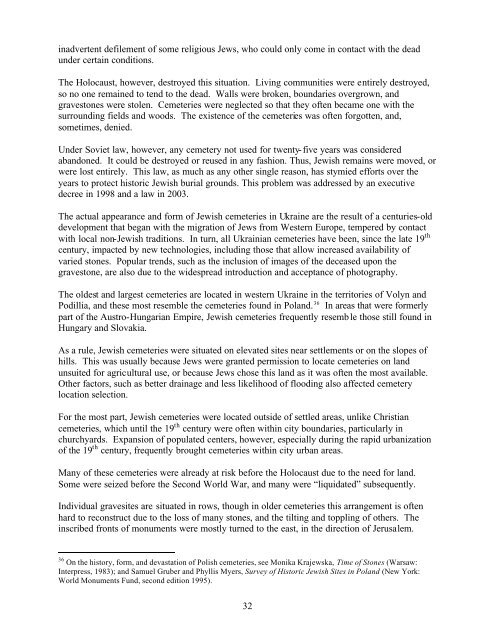jewish cemeteries, synagogues, and mass grave sites in ukraine
jewish cemeteries, synagogues, and mass grave sites in ukraine
jewish cemeteries, synagogues, and mass grave sites in ukraine
Create successful ePaper yourself
Turn your PDF publications into a flip-book with our unique Google optimized e-Paper software.
<strong>in</strong>advertent defilement of some religious Jews, who could only come <strong>in</strong> contact with the dead<br />
under certa<strong>in</strong> conditions.<br />
The Holocaust, however, destroyed this situation. Liv<strong>in</strong>g communities were entirely destroyed,<br />
so no one rema<strong>in</strong>ed to tend to the dead. Walls were broken, boundaries overgrown, <strong>and</strong><br />
<strong>grave</strong>stones were stolen. Cemeteries were neglected so that they often became one with the<br />
surround<strong>in</strong>g fields <strong>and</strong> woods. The existence of the <strong>cemeteries</strong> was often forgotten, <strong>and</strong>,<br />
sometimes, denied.<br />
Under Soviet law, however, any cemetery not used for twenty-five years was considered<br />
ab<strong>and</strong>oned. It could be destroyed or reused <strong>in</strong> any fashion. Thus, Jewish rema<strong>in</strong>s were moved, or<br />
were lost entirely. This law, as much as any other s<strong>in</strong>gle reason, has stymied efforts over the<br />
years to protect historic Jewish burial grounds. This problem was addressed by an executive<br />
decree <strong>in</strong> 1998 <strong>and</strong> a law <strong>in</strong> 2003.<br />
The actual appearance <strong>and</strong> form of Jewish <strong>cemeteries</strong> <strong>in</strong> Ukra<strong>in</strong>e are the result of a centuries-old<br />
development that began with the migration of Jews from Western Europe, tempered by contact<br />
with local non-Jewish traditions. In turn, all Ukra<strong>in</strong>ian <strong>cemeteries</strong> have been, s<strong>in</strong>ce the late 19 th<br />
century, impacted by new technologies, <strong>in</strong>clud<strong>in</strong>g those that allow <strong>in</strong>creased availability of<br />
varied stones. Popular trends, such as the <strong>in</strong>clusion of images of the deceased upon the<br />
<strong>grave</strong>stone, are also due to the widespread <strong>in</strong>troduction <strong>and</strong> acceptance of photography.<br />
The oldest <strong>and</strong> largest <strong>cemeteries</strong> are located <strong>in</strong> western Ukra<strong>in</strong>e <strong>in</strong> the territories of Volyn <strong>and</strong><br />
Podillia, <strong>and</strong> these most resemble the <strong>cemeteries</strong> found <strong>in</strong> Pol<strong>and</strong>. 36 In areas that were formerly<br />
part of the Austro-Hungarian Empire, Jewish <strong>cemeteries</strong> frequently resemble those still found <strong>in</strong><br />
Hungary <strong>and</strong> Slovakia.<br />
As a rule, Jewish <strong>cemeteries</strong> were situated on elevated <strong>sites</strong> near settlements or on the slopes of<br />
hills. This was usually because Jews were granted permission to locate <strong>cemeteries</strong> on l<strong>and</strong><br />
unsuited for agricultural use, or because Jews chose this l<strong>and</strong> as it was often the most available.<br />
Other factors, such as better dra<strong>in</strong>age <strong>and</strong> less likelihood of flood<strong>in</strong>g also affected cemetery<br />
location selection.<br />
For the most part, Jewish <strong>cemeteries</strong> were located outside of settled areas, unlike Christian<br />
<strong>cemeteries</strong>, which until the 19 th century were often with<strong>in</strong> city boundaries, particularly <strong>in</strong><br />
churchyards. Expansion of populated centers, however, especially dur<strong>in</strong>g the rapid urbanization<br />
of the 19 th century, frequently brought <strong>cemeteries</strong> with<strong>in</strong> city urban areas.<br />
Many of these <strong>cemeteries</strong> were already at risk before the Holocaust due to the need for l<strong>and</strong>.<br />
Some were seized before the Second World War, <strong>and</strong> many were “liquidated” subsequently.<br />
Individual <strong>grave</strong><strong>sites</strong> are situated <strong>in</strong> rows, though <strong>in</strong> older <strong>cemeteries</strong> this arrangement is often<br />
hard to reconstruct due to the loss of many stones, <strong>and</strong> the tilt<strong>in</strong>g <strong>and</strong> toppl<strong>in</strong>g of others. The<br />
<strong>in</strong>scribed fronts of monuments were mostly turned to the east, <strong>in</strong> the direction of Jerusalem.<br />
36 On the history, form, <strong>and</strong> devastation of Polish <strong>cemeteries</strong>, see Monika Krajewska, Time of Stones (Warsaw:<br />
Interpress, 1983); <strong>and</strong> Samuel Gruber <strong>and</strong> Phyllis Myers, Survey of Historic Jewish Sites <strong>in</strong> Pol<strong>and</strong> (New York:<br />
World Monuments Fund, second edition 1995).<br />
32









